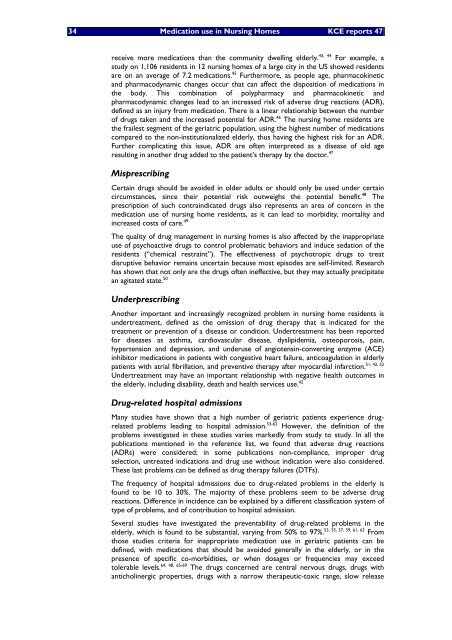Medication use in rest and nursing homes in Belgium. - KCE
Medication use in rest and nursing homes in Belgium. - KCE
Medication use in rest and nursing homes in Belgium. - KCE
You also want an ePaper? Increase the reach of your titles
YUMPU automatically turns print PDFs into web optimized ePapers that Google loves.
34 <strong>Medication</strong> <strong>use</strong> <strong>in</strong> Nurs<strong>in</strong>g Homes <strong>KCE</strong> reports 47<br />
receive more medications than the community dwell<strong>in</strong>g elderly. 43, 44 For example, a<br />
study on 1,106 residents <strong>in</strong> 12 nurs<strong>in</strong>g <strong>homes</strong> of a large city <strong>in</strong> the US showed residents<br />
are on an average of 7.2 medications. 45 Furthermore, as people age, pharmacok<strong>in</strong>etic<br />
<strong>and</strong> pharmacodynamic changes occur that can affect the disposition of medications <strong>in</strong><br />
the body. This comb<strong>in</strong>ation of polypharmacy <strong>and</strong> pharmacok<strong>in</strong>etic <strong>and</strong><br />
pharmacodynamic changes lead to an <strong>in</strong>creased risk of adverse drug reactions (ADR),<br />
def<strong>in</strong>ed as an <strong>in</strong>jury from medication. There is a l<strong>in</strong>ear relationship between the number<br />
of drugs taken <strong>and</strong> the <strong>in</strong>creased potential for ADR. 46 The nurs<strong>in</strong>g home residents are<br />
the frailest segment of the geriatric population, us<strong>in</strong>g the highest number of medications<br />
compared to the non-<strong>in</strong>stitutionalized elderly, thus hav<strong>in</strong>g the highest risk for an ADR.<br />
Further complicat<strong>in</strong>g this issue, ADR are often <strong>in</strong>terpreted as a disease of old age<br />
result<strong>in</strong>g <strong>in</strong> another drug added to the patient s therapy by the doctor. 47<br />
Misprescrib<strong>in</strong>g<br />
Certa<strong>in</strong> drugs should be avoided <strong>in</strong> older adults or should only be <strong>use</strong>d under certa<strong>in</strong><br />
circumstances, s<strong>in</strong>ce their potential risk outweighs the potential benefit. 48 The<br />
prescription of such contra<strong>in</strong>dicated drugs also represents an area of concern <strong>in</strong> the<br />
medication <strong>use</strong> of nurs<strong>in</strong>g home residents, as it can lead to morbidity, mortality <strong>and</strong><br />
<strong>in</strong>creased costs of care. 49<br />
The quality of drug management <strong>in</strong> nurs<strong>in</strong>g <strong>homes</strong> is also affected by the <strong>in</strong>appropriate<br />
<strong>use</strong> of psychoactive drugs to control problematic behaviors <strong>and</strong> <strong>in</strong>duce sedation of the<br />
residents ( chemical <strong>rest</strong>ra<strong>in</strong>t ). The effectiveness of psychotropic drugs to treat<br />
disruptive behavior rema<strong>in</strong>s uncerta<strong>in</strong> beca<strong>use</strong> most episodes are self-limited. Research<br />
has shown that not only are the drugs often <strong>in</strong>effective, but they may actually precipitate<br />
an agitated state. 50<br />
Underprescrib<strong>in</strong>g<br />
Another important <strong>and</strong> <strong>in</strong>creas<strong>in</strong>gly recognized problem <strong>in</strong> nurs<strong>in</strong>g home residents is<br />
undertreatment, def<strong>in</strong>ed as the omission of drug therapy that is <strong>in</strong>dicated for the<br />
treatment or prevention of a disease or condition. Undertreatment has been reported<br />
for diseases as asthma, cardiovascular disease, dyslipidemia, osteoporosis, pa<strong>in</strong>,<br />
hypertension <strong>and</strong> depression, <strong>and</strong> under<strong>use</strong> of angiotens<strong>in</strong>-convert<strong>in</strong>g enzyme (ACE)<br />
<strong>in</strong>hibitor medications <strong>in</strong> patients with congestive heart failure, anticoagulation <strong>in</strong> elderly<br />
patients with atrial fibrillation, <strong>and</strong> preventive therapy after myocardial <strong>in</strong>farction.<br />
51, 42, 52<br />
Undertreatment may have an important relationship with negative health outcomes <strong>in</strong><br />
the elderly, <strong>in</strong>clud<strong>in</strong>g disability, death <strong>and</strong> health services <strong>use</strong>. 42<br />
Drug-related hospital admissions<br />
Many studies have shown that a high number of geriatric patients experience drugrelated<br />
problems lead<strong>in</strong>g to hospital admission. 53-62 However, the def<strong>in</strong>ition of the<br />
problems <strong>in</strong>vestigated <strong>in</strong> these studies varies markedly from study to study. In all the<br />
publications mentioned <strong>in</strong> the reference list, we found that adverse drug reactions<br />
(ADRs) were considered; <strong>in</strong> some publications non-compliance, improper drug<br />
selection, untreated <strong>in</strong>dications <strong>and</strong> drug <strong>use</strong> without <strong>in</strong>dication were also considered.<br />
These last problems can be def<strong>in</strong>ed as drug therapy failures (DTFs).<br />
The frequency of hospital admissions due to drug-related problems <strong>in</strong> the elderly is<br />
found to be 10 to 30%. The majority of these problems seem to be adverse drug<br />
reactions. Difference <strong>in</strong> <strong>in</strong>cidence can be expla<strong>in</strong>ed by a different classification system of<br />
type of problems, <strong>and</strong> of contribution to hospital admission.<br />
Several studies have <strong>in</strong>vestigated the preventability of drug-related problems <strong>in</strong> the<br />
elderly, which is found to be substantial, vary<strong>in</strong>g from 50% to 97%. 53, 55, 57, 59, 61, 63 From<br />
those studies criteria for <strong>in</strong>appropriate medication <strong>use</strong> <strong>in</strong> geriatric patients can be<br />
def<strong>in</strong>ed, with medications that should be avoided generally <strong>in</strong> the elderly, or <strong>in</strong> the<br />
presence of specific co-morbidities, or when dosages or frequencies may exceed<br />
tolerable levels. 64, 48, 65-69 The drugs concerned are central nervous drugs, drugs with<br />
antichol<strong>in</strong>ergic properties, drugs with a narrow therapeutic-toxic range, slow release

















